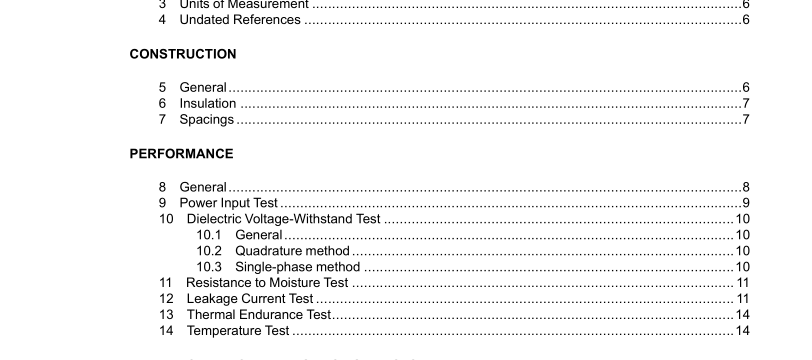UL 1030-2019 pdf download.Sheathed Heating Elements.
1 Scope 1.1 These requirements cover metal-sheathed heating elements intended for use in appliances and equipment that comply with the requirements for such appliances and equipment. 1.2 i The main body of this standard covers requirements for sheathed heating elements rated 600 volts or less. Supplement SA covers cartridge-type sheathed heating elements that do not incorporate a bend in the sheath, rated between 601 and 15,000 V. 1.3 These requirements do not cover heating elements for use in equipment for use in hazardous locations as defined in the National Electrical Code, NFPA 70. 1.4 Wherever the terms heating element and element are used in these requirements, they are intended to mean a sheathed heating element as defined in 2.4. 2 Glossary 2.1 For the purpose of this standard the following definitions apply. 2.2 DIELECTRIC VOLTAGE WITHSTAND – The ability of a heating element to withstand specified voltages applied between current-carrying parts and dead metal parts for specified times without flashover or puncture. 2.3 LEAKAGE CURRENT – A current, including a capacitively coupled current, that may be conveyed between exposed conductive surfaces of a heating element and ground. 2.4 SHEATHED HEATING ELEMENT – A resistance element that is usually encased in magnesium oxide or encased in a similar insulating material that is, in turn, surrounded by a metal sheath. 2.5 SHEATH WATTAGE DENSITY – The watts per unit area of actively heated sheath surface area. The actively heated sheath surface area is considered to be the area of the exposed surface of that portion of the sheathed heating element between the terminal pins. See Figure 2.1.
5.5 The values in Table 5.1 are intended to specify a minimum thickness for a sheath made of steel, titanium, copper, copper-clad steel, or steel and nickel alloys. Increased thickness may be required, based upon the particular end-use application of the heating element. A sheath made of aluminum or aluminum alloy and a sheath having a thickness less than specified in Table 5.1 is to be investigated under conditions of actual service to determine if it has the necessary mechanical properties and will withstand the most severe conditions likely to be met in service. 6 Insulation 6.1 An insulating washer, a bushing, or the like, that is an integral part of a heating element shall be of a material resistant to moisture, such as porcelain, and shall be acceptable for use at the maximum temperature to which it will be subjected under conditions of actual use. Such parts shall have adequate mechanical strength and rigidity to withstand the stress of actual service. 6.2 Insulating material employed in an integral part of a heating element, such as a terminal block, or the like, shall be strong, not easily ignited, and resistant to moisture. A material other than porcelain, phenolic, or one that is known to be acceptable for the support of current-carrying parts shall be investigated under conditions of actual service to determine if it has the necessary electrical and mechanical properties and will withstand the most severe conditions likely to be met in service. 6.3 The thickness of magnesium oxide (MgO) or other similar insulating material between the resistance element and the inside of the sheath, and the material of an end seal between the terminal pin and the inside of the sheath shall not be: a) Less than 0.016 inch (0.41 mm) for elements rated 300 volts or less, and b) Less than 0.031 inch (0.79 mm) for elements rated more than 300 volts.
Exception No. 1: When exact centering ofa terminal pin is required to maintain the 1/16 inch spacing, a spacing of3/64 inch (1.2 mm) in one location meets the intent ofthe requirement. Exception No. 2: For an element rated 300 volts or less, a spacing not less than 3/64 inch measured between a terminal pin and the sheath is acceptable at a closed-in void, such as between an end seal and the element insulating material. See Figure 7.1. Exception No. 3: For an element rated more than 300 volts, a spacing not less than 3/64 inch measured between terminal pin and sheath is acceptable when a closed-in void is not present between an end seal and element insulation ofdissimilarmaterials.UL 1030-2019 pdf download.
UL 1030-2019 pdf download
